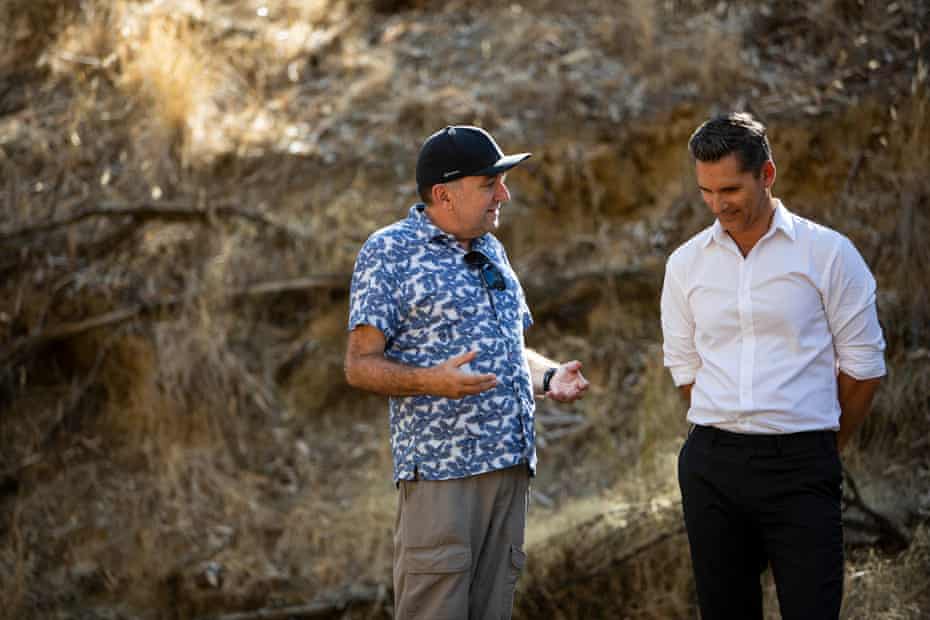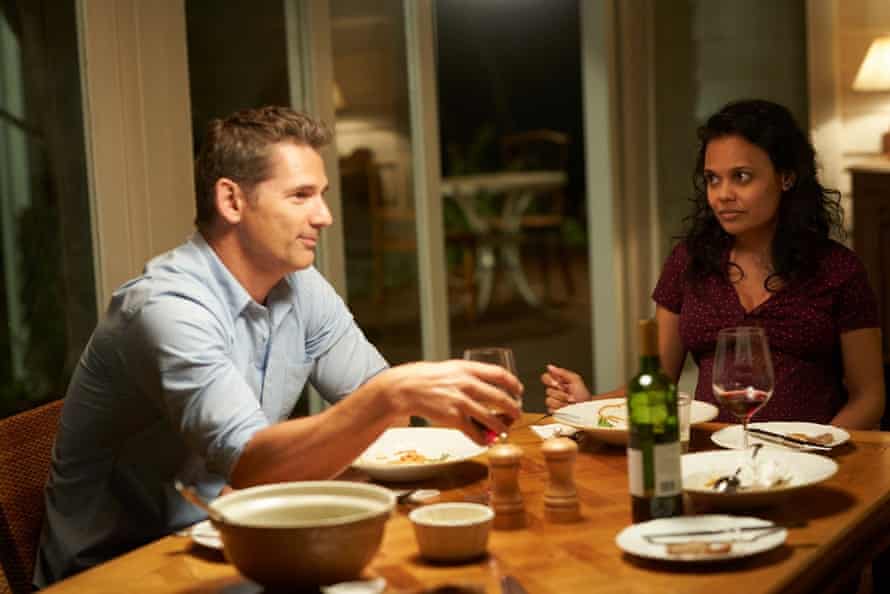Released in 2016, Jane Harper’s debut novel, The Dry, evoked a sense of sundried desperation and El Niño-inspired unease that felt as familiar to many Australian readers as the book’s genre trappings (its tagline, “a desperate act in a small town with secrets”, could apply to anything from Twin Peaks to Top of the Lake).
The book hadn’t even hit shelves when producer Bruna Papandrea and screenwriter-director Robert Connolly started planning the film. Papandrea is perhaps best known today for adapting Liane Moriarty’s Big Little Lies for HBO, which swapped Sydney’s northern beaches for affluent, coastal California – but there was no separating The Dry from its western Victorian backdrop.
“It just lends itself to mystery and suspense so well because you do have that undercurrent of danger in a lot of locations,” Harper says.
Whether set in state forests, coastal communities or great, thirsty expanses of agricultural land, her four novels to date pick up on the duelling sensibilities of romanticism and dread that have recurred in Australian storytelling since colonisation. “It’s quite easy for things to go wrong quite quickly, which is a real gift for a writer.”
The Dry, which opens in cinemas on Friday, follows off-duty Australian federal police detective Aaron Falk (Bana), who is reluctantly dragged back to his fictional hometown of Kiewarra after his childhood friend is found shot, dead along with their wife and son.
The current case, and Falk’s presence in town, are complicated by his own implication in the death of another friend, Ellie (BeBe Bettencourt), decades earlier.
Before making the film, Connolly hit the road with Bana so the pair could immerse themselves in the world of the book. “You drive one, two, three hours out of Melbourne, and by the time you cross four you’re into the Mallee region and the landscape changes immensely,” Connolly says. “I fell in love with it; it’s the most beautiful, extraordinary place. But it’s tough … you feel this muscular, tough lifestyle of the landscape set against its beauty.”
In this tension, Harper’s characters inherit a settler narrative of pioneers carving hard-won homes and livelihoods from an often inhospitable, alien outback. It’s also part of a nation-building mythology that helped launder the realities of dispossession and environmental degradation on unceded country. (The Dry’s story of a complicated small-town homecoming rings very differently to that of Wiradjuri author’s Tara June Winch’s The Yield; in the film, a retired farmer, played by Bruce Spence, laments without irony how the automation of agriculture could all but clear the region of its people and communities – imagine that.)
Like the novel, the film’s slow-burning plot crackles with other 21st century pressures and anxieties that seem ripped straight from a Four Corners report. While the apparent murder-suicide that initially draws Falk back home echoes all-too-common acts of male-perpetrated family violence, Harper’s books are also peppered with corporate crime, revenge porn, gambling addiction, crippling debt, preyed-upon backpackers and toxic masculinity that sweats into hi-vis and private school uniforms alike. Onscreen, Connolly frames Harper’s characters like ants set against the vastness of the landscape – and the scale of their problems.
“Something Eric and I talked a lot about early on was not judging the characters that live in that world,” says Connolly, who also drew inspiration from Roman Polanski’s similarly water-driven whodunnit Chinatown. “There’s a version of these stories that’s like Deliverance – ‘urban character gets stuck in dark, horrific regional place’ – and that wasn’t our intention. We had to look deep into the heart of these damaged characters and the tough luck they’ve had, and find the humanity.”

For Harper, that humanity was grounded in her 13 years as a print journalist. “It gave me a really good ability to listen to people’s stories and try to find a human element behind the headlines.”
Inevitably, the greatest of the pressures facing these characters are drought and fire, both worsened by a changing climate that, counter to the denial of federal ministers in Akubra-and-moleskin cosplay, is evident on the land. Like its source novel, The Dry ties into a wave of recent local literature from Alice Bishop’s A Constant Hum to Jennifer Mills’ Dyschronia that reflect upon the impact of ecological disaster on small communities.
“When I moved back to Australian in 2008 I got sent on a fire safety course as a reporter, so I could be safe in the event that I would have to go out and cover a bushfire,” Harper says. “I was stunned by what I saw and learned – I’d never seen that portrayal of fire. How quickly it goes from OK to deadly in the space of minutes, that’s always stayed with me.”
Connolly says: “The big image of the film is Aaron standing in a river that’s now completely dry and remembering himself 25 years ago, swimming with his friends. It’s kind of devastating imagery.
“Climate change and its impact on the land were present with us all the time,” he adds. “We were filming out in a part of Australia that is doing it really tough. Beulah, the town [on the poster], has drinking water issues. It’s ever present. Farmers are growing different grains than they used to because there’s not enough water, they’re adapting.”

Much has changed since filming was completed in 2019. After the carnage of last summer’s bushfires, Australia is now entering a typically wetter (if still record-breaking) La Niña period. Worldwide protests have seen the very nature of the cop-centric crime drama reappraised. And now The Dry hits cinemas during a different kind of dry spell, as one of few new releases on what is typically one of Hollywood’s biggest days of the year.
“We really tried to make this kind of, we call it, ‘hyper-Australian’ cinema,” Connolly says. “A big Australian film: big landscapes, big stories, music, stars – one that brings Australian audiences to the cinema to watch.”
A year of lockdowns might also grant the film an edge neither Harper or Connolly could have scripted: only in 2020 could 117 minutes of a maskless Eric Bana freely travelling around the Victorian countryside also qualify as escapist fantasy.
• The Dry is in cinemas from 1 January
The Link LonkDecember 26, 2020 at 02:00AM
https://www.theguardian.com/film/2020/dec/24/the-dry-the-devastating-imagery-bringing-jane-harpers-bestseller-to-the-big-screen
The Dry: the ‘devastating imagery’ bringing Jane Harper’s bestseller to the big screen - The Guardian
https://news.google.com/search?q=dry&hl=en-US&gl=US&ceid=US:en

No comments:
Post a Comment